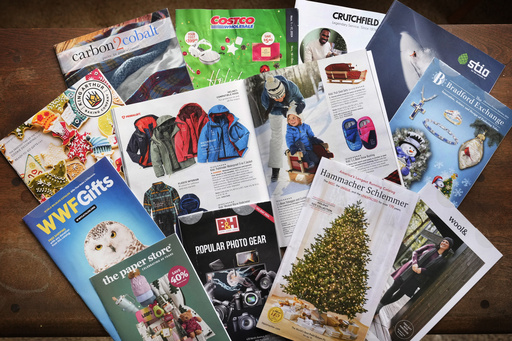
PORTLAND, Maine — The trend this holiday season sees a shrinkage in the size of printed gift catalogs reaching customers’ mailboxes. While retailers are aiming for a robust sales period, they are opting for smaller formats in their catalogs as a way to save on both postage and printing costs. This shift has led to the emergence of tiny versions of what were once sizeable gift guides, with companies like Lands’ End, Duluth Trading Company, and Hammacher Schlemmer among those adapting to this trend. Some retailers have even chosen to distribute postcards instead, further reducing expenses.
In Portland, Maine, tech-savvy shopper Lisa Ayoob was struck by the diminutive size of a catalog sent by the outdoor apparel brand Carbon2Cobalt, commenting, “It almost felt like it was a pamphlet compared to a catalog.” Over the years, catalogs have been modified in response to technological advances and changing consumer habits. Once characterized by thick, hefty editions, catalogs have transitioned to more focused mailings as online shopping has become more prevalent. The recent increases in postal rates have further propelled the industry toward smaller formats.
Data reveals that between 2006 and 2018, the volume of mailed catalogs decreased by approximately 40%, with around 11.5 billion sent during that time. In light of this significant shift, the trade group, which was formerly known as the American Catalog Mailers Association, has rebranded itself to the American Commerce Marketing Association, indicating a broader scope of focus.
Nonetheless, catalogs are far from extinct; they have found ways to remain relevant even in the age of e-commerce. Retailers have discovered that lighter catalogs—fewer pages—can still serve as effective marketing tools when paired with QR codes and promotional offers, enticing consumers to visit their websites for more purchases.
Although producing and distributing catalogs remains expensive, their value is increased by the rising costs of digital advertising. This helps retailers stand out in a market saturated with various advertising methods, according to industry experts. In a surprising turn, large e-commerce platforms such as Amazon and Wayfair have begun sending out their own catalogs in recent years. Amazon, for instance, started distributing a toy catalog in 2018, marking the same year Sears declared bankruptcy, following a legacy that included its iconic Christmas Wish Book launched in 1933.
Consumers who appreciate printed material may find solace in J.Crew’s revival of its classic glossy catalog this year. Studies suggest that the tactile experience of flipping through a paper catalog has a more significant impact on buyers. Jonathan Zhang, a marketing professor at Colorado State University, explains that people tend to remember information better when they read it in a physical format. He states, “Our brains haven’t evolved quickly enough to keep up with technology, and that’s why traditional books still hold relevance. Three-dimensional experiences are more memorable.” Zhang adds that smaller catalogs can still achieve their goal of captivating consumers, especially since younger demographics are increasingly concerned about environmental sustainability.
Rising postal costs are expediting these changes, with recent hikes impacting sizes that were once standard in the catalog industry. In response, retailers are adjusting their catalogs to fit into more affordable postage categories. One format, known as a “slim jim,” measures 10.5 by 5.5 inches, while some retailers are even sending larger postcards to cut costs further.
Lands’ End is experimenting with different compact formats alongside its traditional catalogs, including folded brochures and postcards, as noted by Chief Transformation Officer Angie Rieger. Maine resident Ayoob, while not particularly fond of traditional catalogs, acknowledges their role in marketing. She prefers online shopping over flipping through physical pages but recognizes that companies want exposure to stand out amidst an overwhelming array of brands and websites.
The concept of targeting customers through mail is not new; L.L. Bean pioneered the mail-order catalog by promoting their signature product, the “Maine Hunting Shoe,” to out-of-state hunting license holders in 1912. The Freeport-based company continues to distribute regular-sized catalogs due to their strong association with the brand, as noted by spokesperson Amanda Hannah. “By showcasing our icons, the catalog became an icon itself,” she said, reinforcing its importance in the company’s comprehensive marketing strategy, particularly for its devoted customers.
